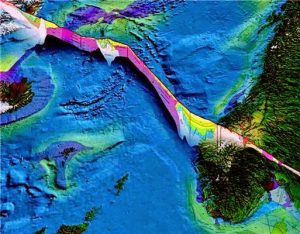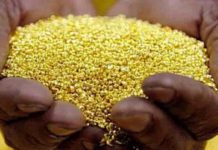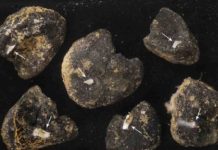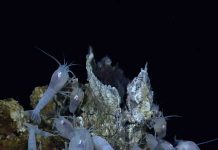
Credit: Geological Survey of Norway
The mid-ocean ridges where tectonic plates meet in the Atlantic and the Pacific Oceans are seething with volcanic activity. The most active areas are deep under water, several thousand metres down. Ocean water penetrates several kilometres down towards the centre of Earth where the crust is fractured. Geologists call this hydrothermal activity.
Liquid magma heats the water to about 400 °C before the water squirts back out again as an underwater geyser. The ocean water draws minerals and metals out of Earth’s crust and carries these back up to the seabed. Gold, silver, copper, cobalt, zinc, and lead are all deposited when the hot springs meet the cold ocean water.
This process formed the foundation for the land-based mines we have as well. The Norwegian ore deposits in Sulitjelma, Kongsberg and Røros were underwater 500 million years ago. But now, mines in Norway and elsewhere in the world are starting to run low on easily accessible ores. This coincides with a drastically increased demand for metals.
Several countries, including Norway, are now examining the possibility of mining the ocean floor.
Mapping the Mid-Atlantic Ridge
The Norwegian University of Science and Technology (NTNU), Statoil, and the mining company Nordic Mining are collaborating on a research project that will map marine mineral resources along the Mid-Atlantic Ridge. The parties signed a one-year collaboration agreement at the end of November 2012.
“Our primary goal is to map potential resources,” says Fredrik Søreide, an adjunct professor at NTNU’s Department of Marine Technology who is heading up the project. “We can then prioritize research and development as we move ahead.”
Researchers from the university’s Department of Geology and Mineral Resources Engineering and Applied Underwater Robotics Laboratory will also participate in this project.
The University of Bergen (UiB) has already gathered interesting samples from the Mid-Atlantic Ridge. The samples were extracted from the ridge in the area between Jan Mayen Island and the Fram Strait, off the east coast of Greenland. The researchers discovered an area of interest close to Jan Mayen in 2005. They named the area Soria Moria, after a castle in a Norwegian fairy tale.
Loki’s Castle
UiB’s scientists identified another large hydrothermal field with rich mineral deposits 300 km west of Bjørnøya in 2008. This field is located 2300 metres below the surface of the ocean. The field was named Loki’s Castle. It was hard to find, and was thus named after the Norse god Loki, who was a master of disguise. Loki’s Castle is the northernmost hydrothermal field that has been charted so far.
The researchers on the project will continue to map the ocean floor along the Mid-Atlantic Ridge for potential mineral deposits, using images from echo sounders and remotely operated submersible vessels.
“We still have many years of data collection ahead of us,” Søreide says. “But I do believe that Norway, with all of its offshore experience, is in a good position to develop this potential. It is likely that the mining industry will move offshore eventually, the same way that the petroleum industry did.
First minerals from the sea
The Canadian company Nautilus Minerals is the leader in marine mineral exploration. Nautilus Minerals has developed robotic technology for deep-sea mining in collaboration with the French company Technip. The company is planning to open the first deep-water mine in 2015. The Solwara 1 mine will be located 1600 metres below sea level. The company has found large deposits of copper and gold there. Solwara 1 is located in the Pacific Ocean, north of Australia, in Papua New Guinea.
Nautilus Minerals plans to continue searching for additional commercially viable deposits of copper, gold, zinc, and silver outside of Fiji, Tonga, the Solomon Islands, Vanuatu, and in the western part of the Pacific Ocean. Solwara 1 was supposed to start operations in 2013, but this was postponed. Local activists say that the environmental impact of the mine has not been fully investigated. The government of the independent island state of Papua New Guinea is currently negotiating with the mining company in terms of investments and profits.
Robots mining for gold
Nautilus Minerals will use submersible robots to work on the ocean floor and break apart loose ore. A pipeline will then transport the ore to a specialty vessel on the surface, which then will transport the ore to shore for refining.
“This is an extremely rich deposit of gold and copper,” says Terje Bjerkgård from Norway’s Geological Survey (NGU). He studies mineral resources and has participated in two research expeditions that included the area around Papua New Guinea.
“Underwater mining will first be commercialized in the Pacific,” he says. “The largest known deposit on the ocean floor is in Middle Valley in the northeast Pacific Ocean, off Canada. Other interesting deposits are north of New Zealand. Underwater mining will become more viable as land-based deposits become harder and more expensive to exploit. The challenges are tied to the distinct fauna around the hot springs.”
Black smokers
Rolf B. Pedersen, a professor at the University of Bergen, has been active in the exploration of the ocean floor along the Mid-Atlantic ridge. He is head of the Centre for Geobiology, which examines volcanic hydrothermal activity and the formation of the mineral resources. The Centre also conducts research on the biodiversity around underwater hot springs, including extremophile bacteria (bacteria that live in extreme environments). The Mid-Atlantic Ridge is populated by a unique fauna and flora. Scientists at the Centre discovered ten new species just in the area around Loki’s Castle. The mineral-rich water is the reason for the diversity.
Steaming chimneys called black smokers protrude from the volcanic areas at the bottom of the oceans. They can be several tens of metres tall, and grow as minerals are deposited when the hot water meets the cold ocean water at the outlet of the hydrothermal vents. Some of the metal sulphides precipitate right by the outlet, which contributes deposits that expand the structures, while the rest turn into a black smoke that the water pressure pumps into the water. The temperature of the water inside the “chimneys” can be as high as 400 °C.
The origin of life?
Hydrothermal chimneys were first observed in 1979, two years after hot springs were discovered close to the Galapagos Islands. The researchers used the submersible vessel Alvin to make the surprising discovery that volcanic areas are home to biological communities that derive their energy from chemical energy and not from sunlight. They also discovered a range of new and unknown species by the thermal vents.
The chemotrophic bacteria that live in and around the hydrothermal vents are able to use chemical energy from the mineral-rich water. The process provides all the energy this unique ecosystem requires to live. The discovery also created an understanding that the origin of life on Earth was not necessarily dependent on photosynthesis and sunlight.
“The environmental impact has not yet been examined,” says Pedersen. “The University of Bergen is a part of an international consortium that has applied for EU funding to examine the environmental impact. These special ecosystems mean it would only be appropriate to operate prospective mining operation in areas where the hydrothermal activity has ceased. However, industrial activities involve environmental consequences that have to be measured against the value of the activity.”
Obstacles beneath the surface
The problem is that inactive fields are very hard to discover with existing technology, which means that only active black smokers are currently being explored. This poses enough substantial enough challenges in and of itself, including environmental issues, technology, and great depths. Many countries are active in securing rights to underwater mineral resources, even though the start of large-scale mining efforts remains years away.
“Many countries, such as China, Russia, Japan, France and India, are positioning themselves strategically to secure resource areas in international waters,” says Søreide. “The politics of international oceans is full of intricate details, with a lot of the laws tied to the international laws of the sea.”
Interested governments have recently created rules for prospecting in international waters. Countries that have ratified the United Nations Convention on the Law of the Sea are bound by these rules. The US is among the countries that have not ratified the Convention.
Future Norwegian industry?
Norway is in special situation in regards to deep-water mining.
“Norway is unique in that these resources are within the Norwegian economic zone,” says Pedersen. “That means that underwater mining could be a future industry, when the technology is in place and if the environmental impacts are acceptable. The deposits have to be relatively big for the endeavour to be commercially profitable. There are big differences between the various estimates provided by researchers. We are trying to clarify the resource base, and need systematic studies regarding the deposits.”
This is exactly what the NTNU research project will contribute.








